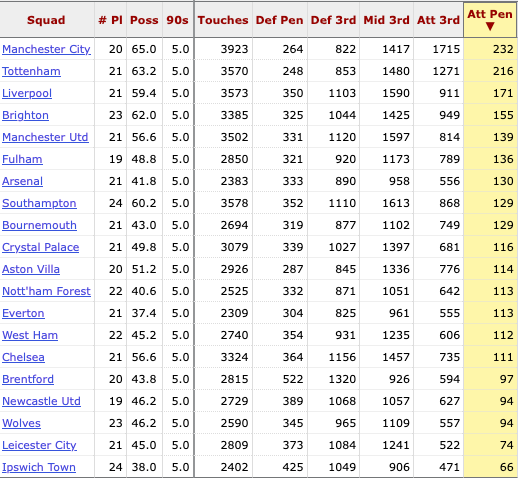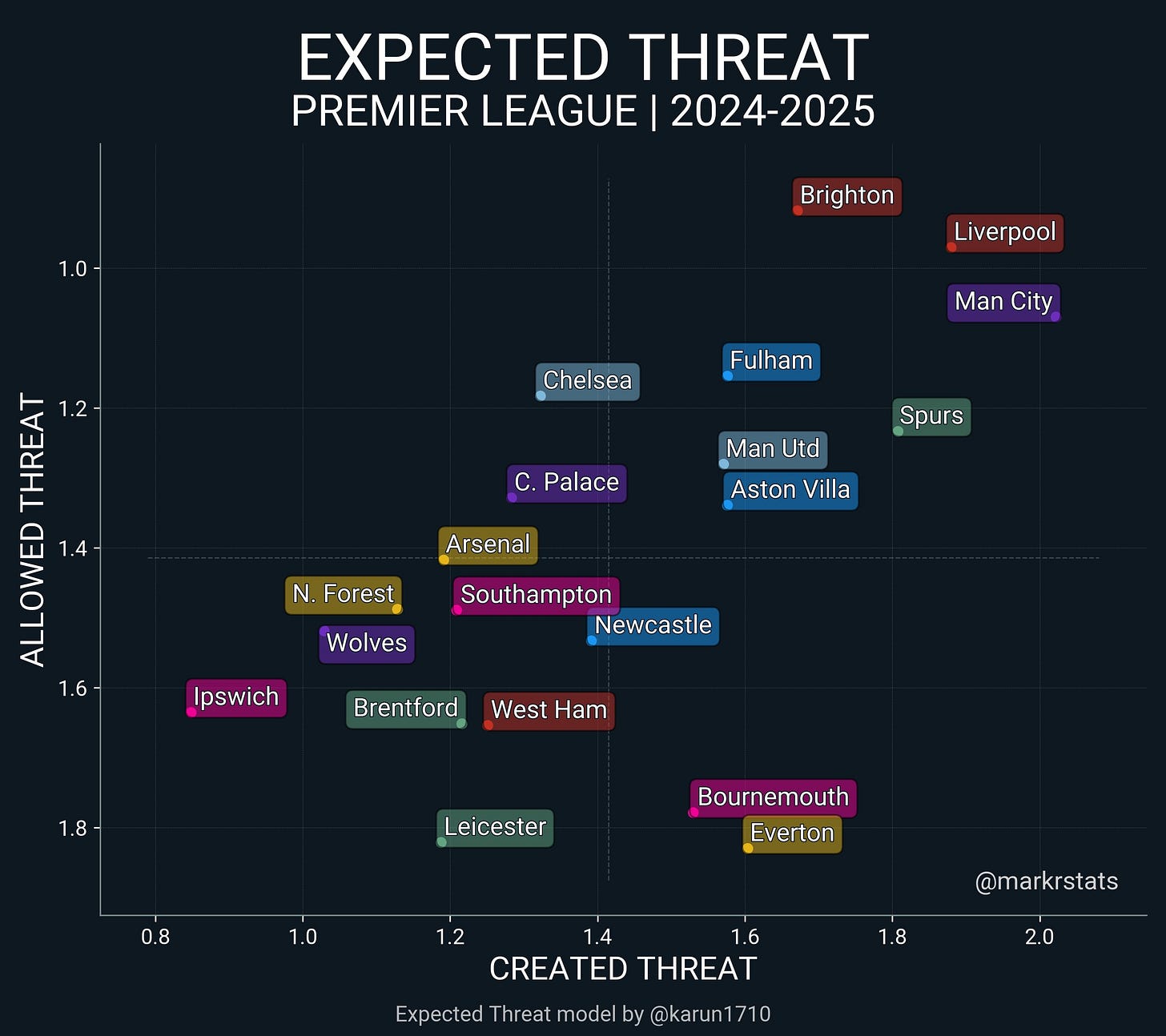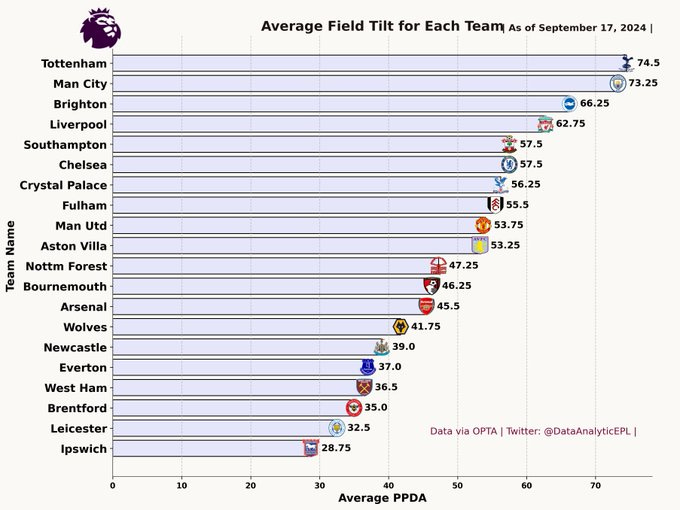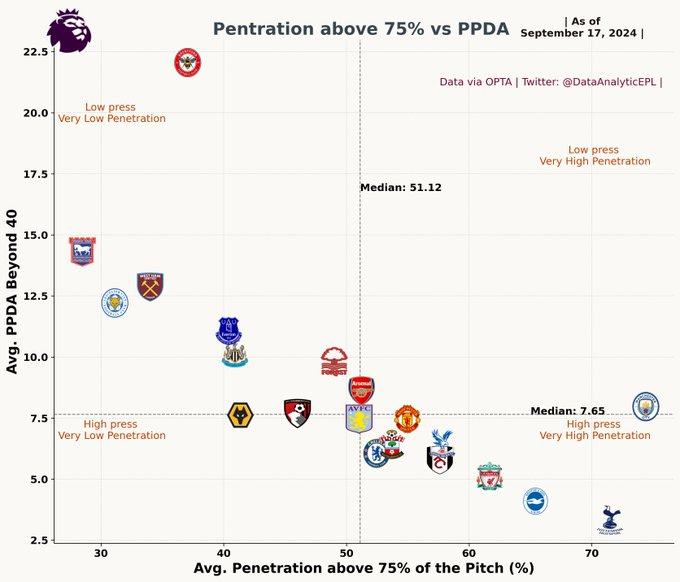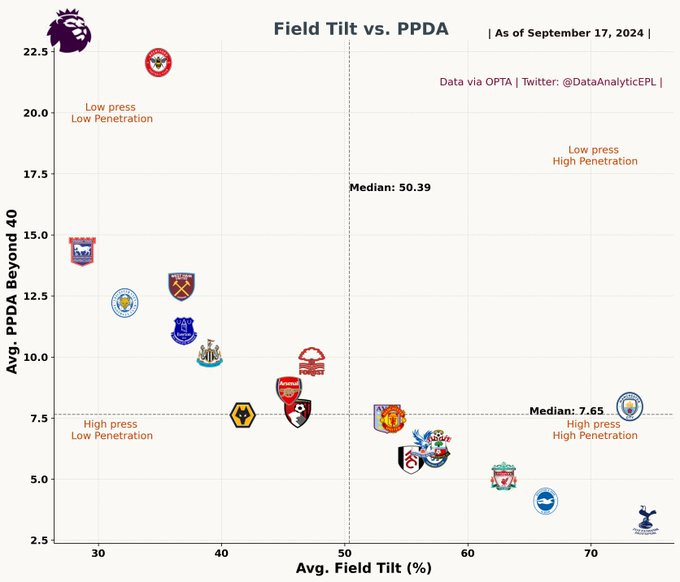The Big Question about Spurs' Underlying Numbers So Far
And what I think is the correct answer.
Just five games into the new season, the eyeball consensus is that Spurs have looked good but produced mixed results. The opening draw against newly promoted Leicester City was disappointing—especially in the manner in which we conceded the equalizer—and losses to Newcastle away and Arsenal at home are unacceptable results for any team looking to challenge at the top of the table, even if both of those matches could easily have gone the other way.
The big question on the minds of many Spurs fans and pundits at this early point in the season is this:
Are we seeing an underperformance so far from Spurs, or is this just who are, mate?
I’m going to answer this question using underlying performance data from our first five games. The usual caveat applies here (hence the tongue-in-cheek graphic above): it’s only five games’ worth of data. But with a mix of poor (Everton), tricky (Brentford), dangerous (Newcastle), and elite (Arsenal) competition across our opening games, we’re beginning to see some useful patterns.
What Really Happened
If we look at some basic stats that capture our actual performance, I think it’s fair to say our table position (10th, six points off top) is worse than our performance. Spurs have scored the 5th most goals so far in the Premier League, more than Brighton, Arsenal, Newcastle, and Manchester United (charts courtesy of Fbref.com)
If you follow the punditry, you’ve likely gotten the impression that our defensive setup is rash and catastrophically leaky, but the reality is Spurs are tied with Manchester City, Manchester United, Chelsea, and Fulham for the 5th fewest goals conceded so far this season, averaging one goal conceded per game:
Putting these figures together, Spurs are tied with Brighton with the 5th best goal differential in the Premier League so far, which is just one goal off Arsenal’s differential and one better than Villa’s:
The Underlying Numbers
But the underlying numbers are even more impressive.
Spurs have the 4th highest xG so far, ahead of Villa, Chelsea, Brighton, Newcastle, and Arsenal:
Spurs have the 5th lowest xGA so far, better than Chelsea, Arsenal, and Manchester United. That’s right: Arsenal’s ‘best defense in Europe’ has yielded a higher expected goals against thus far in the Premier League than Tottenham’s ‘risky’ ‘naive’ ‘high line.’ Granted, Arsenal have faced tougher competition so far than Spurs have; their defense is unquestionably outstanding. The point here is that Spurs, who’ve faced some tough opponents so far, including Arsenal, are defending much better than the football media would have you believe:
Putting this together, Spurs have the 3rd best xGD in league so far, behind only Manchester City and Liverpool:
The more granular you get, the better it looks.
The above are pretty broad-brush stats, but when you look closer you see, in my view, even more promising data.
Spurs are controlling games with possession, 2nd in the league, behind only Manchester City, whose possession stats just took a huge leap with an outlier performance against Arsenal yesterday, who set deep to defend with 10 men.
For a while it looked like that possession wasn’t going anywhere—like it wasn’t generating chances—but the gap between Spurs’ extremely high possession and occupation of threatening territory on the pitch and Spurs’ chance creation is starting to narrow. As above, Spurs’ xG creation is now 4th in the league, and big chance creation is starting to improve (chart courtesy of the Premier League):
Spurs have also taken the 2nd most shots and the 2nd most shots on target (again, behind City in both categories, who just had a massive outlier performance in this category as well against Arsenal yesterday). Shot quality is also improving; Spurs are tied with Arsenal and Manchester City for 7th best non-penalty expected goals per shot (chart courtesy of Fbref.com):
Spurs are 2nd (again, behind City) in shot creating actions (SCA) and 1st in crosses (charts courtesy of Fbref.com):
An Answer to the Question
All of the above implies that Spurs are performing really well, despite mixed results so far. But there’s more we can do to answer the question of whether our results so far represent an underperformance likely to turn into much better results over the long course of the season, or whether we’re just a really inefficient side who huff and puff but ultimately don’t get anywhere.
The way I answer this question is by looking at the underlying data against some of the improvements we’ve started to see in xG and chance creation. The logic of this answer is that if Spurs are occupying a lot of dangerous territory a lot of the time, it’s very likely that continuing to do so will produce a lot of chances and a lot of goals. In other words, it’s difficult to have that much of the ball in that many threatening situations, especially with the kinds of finishers we have, and not produce a ton of chances and goals.
As of now, Spurs are 2nd in the league in touches both in the opposition final third and in the opposition box (second to City in both categories) (charts courtesy of Fbref.com):
Spurs are also 3rd in the league in expected threat, a measure of how threatening is the territory you occupy with the ball (while allowing the 6th least expected threat) (chart courtesy of markstats):
At the same time, Spurs have been very good at controlling the game with possession and territory. I don’t mean just pretty good; I mean in some cases we’re an extreme positive outlier in these categories. Spurs are sustaining possession not just in their own area or in non-threatening areas, but above 75% of the pitch (charts courtesy of @DataAnalyticEPL on twitter):
We’re also keeping the ball in our opponents’ territory better than anyone else in the league:
And we’re using our high press to penetrate opposition territory better than anyone else in the league:
So when I see these stats and how we compare with the competition, it seems to me that what we’re doing is extremely promising for attacking purposes, and, like Postecoglou teams in prior years and scenarios, it’s just a matter of time before the goals start to flood in.
But what about our ‘naive’ ‘high line’ and ‘risky’ defending?
One of the most interesting things to come out of the early-season data is how much better Spurs’ defending has been, compared both with the general perception and with last season. We can see this in a few ways.
For one, as I’ve said over and over again, we defend from the front, meaning our ability to suffocate the opposition in build-up makes it much harder than last season for teams to find that lethal over-the-top pass into space behind our defensive line.
Passes per defensive action (PPDA) measures how many passes an opponent can string together before being interrupted by the press. Spurs are destroying the league in PPDA measures:
And again, the ability to defend from the front with a relentless press is turning into territory advantage, allowing us to penetrate the opposition’s final third and penalty area after turning the ball over:
That’s great for attacking, but from a defensive standpoint, a much better coordinated and more effective press so far this season is having real defensive payoff. Our opponents are unable to build up enough to threaten us as often as they did last season. Spurs have allowed among the fewest buildups leading to a shot and leading to opposition possession in the final third:
But what about our vulnerability to counterattacks?!!
Pay attention here, because this one is important: Spurs have conceded zero goals on counterattacks so far this season (charts courtesy of WhoScored.com):
In case you’re wondering, we do, however, lead the Premier League in goals scored from counterattacks:
Conclusion
It’s still early, but if you take the data in all of these charts into consideration, I think it’s getting pretty hard to argue that Spurs are just a leaky high-line defending team that’s ‘easy to play against’ and a bunch of no-threat possession merchants who can’t score goals. On the contrary, the underlying numbers are very promising both for our attacking and, perhaps surprisingly, for our defending.
















